Sexual Helix - Alevel Project
- Gus Beech

- Mar 21, 2020
- 7 min read
Updated: Feb 10, 2022
Sexual Helix is a dive into the spectrum of gender performance and sexual habits of curious sea creatures and the relationship humans have with aphrodisiacs and their own sexuality.

Ellie MacDonald was born and raised in Brighton, splitting her time between her studio in her home town and freelancing in London. She trained at Cordwainers, specialising in pattern cutting and construction of leather accessories and currently combines her background in sourcing vintage textiles and machine embroidery into her pieces.
MacDonald works predominantly on a vintage Singer machine and focuses on producing bespoke embroidered commissions and small limited-edition patches that she ells on her online shop. She works collaboratively with other designers and brands branching from interior to fashion and editorial pieces while steadily building her own collection of detailed work.
She finds inspiration from the natural world with sea-life, shells, flowers, foliage, and fruit featuring heavily in her body of work. She likes to experiment with base fabric, whether being sheer or padded to add texture and depth in her patches as well as metallic thread.
The central oyster is an example of MacDonald's work and demonstrates her delicate and detailed style in the form of a machine embroidered patch. An oyster shell in silver metallic thread and additional tones of grey are stitched directly onto navy felt. The raised and varying stitch width creates a smoother textures upon the otherwise rough base fabric.
The artist introduces depth to the piece by using multiple shades of metallic threads that catch the light as well as a glossy pearl bead at the centre. She also uses the ombre of colour from the pearl to guide the viewer around the piece.

The aphrodisiac-like qualities of Papaya are predominantly found in its compounds. It is ripe with nutrients, and is an abundant source of vitamins and magnesium (proven to enhance drive for intercourse). Even though men can achieve new sexual heights with Papaya, it is women that benefit the most from its content. Compounds in the flesh of Papaya induce oestrogen, a female hormone that is essential to intimacy as well as assisting in smoother menstruation and boosting libido.
The yonic appearance of Papaya and its soft flesh has led to it being universally accepted as a sensual fruit due to its sensory appeal. This inviting texture in turn releases dopamine (a chemical that makes humans feel ‘happy’) into the brain.

The mythology of Pomegranate’s sexual allure started back in ancient Greece, where it was the symbol of Aphrodite, Goddess of Love. There is some debate that pomegranate is actually the forbidden fruit in the Garden of Eden, instead of an apple or a fig. It is a fruit that embodies eternal life, as well as being able to improve sexual experiences.
Besides its medicinal purposes, pomegranate is full of vitamin C, which delivers a rush to the body that provides maximum energy for intercourse. It has been shown that men who regularly ingest Pomegranate can see a significant drop in erectile dysfunction and has also been proven to raise levels of testosterone in both sexes.
As a stage in development I stitched Papayas into a sheet of clear plastic and used a heat gun to melt and manipulate the material to emulate the fruit shrivelling and rotting.

Jodie Ruffle is a London based womenswear designer with a background in Haute Couture, working for Alexander McQueen after graduating from Middlesex University.
Ruffle’s personal work focuses on making traditional Haute Couture techniques relevant in contemporary fashion by using playful imagery like fruit and deconstructed plaids and polka dot patterns in her embroidery and embellishment. Her work also challenges opposites - juxtaposing different materials, playing with old and new, and concepts of femininity and masculinity.
The centre picture shows a stylised embroidered pomegranate by Ruffle in tones of pinks, oranges and reds. The eyes immediately focus on the bright red seeds that congregate at the centre of the shape.
Satin stitch is used to emulate the smooth and flat skin of the fruit whilst French knots recreate the bumpy and organic texture on the inside of the pomegranate. The knots assist in making the from feel less flat.
Figs are a paradox in sensual food: their many seeds represent fertility while their leaves are associated with modesty (often depicted as clothing in art). They are also high in potassium and amino acids. Rumoured to be Cleopatra’s favourite fruit, the erotically shaped fig has been associated with sexuality in almost every culture. In Ancient Greece, where they were believed to be a symbol of love, the arrival of a new fig crop elicited a copulatory ritual.

Cherries have a high potassium and vitamin C content which are responsible for producing sexual hormones and stimulating pheromone production. This also have connotations to virginity with the origin of the phrase 'pop your cherry' first appearing in the 16th century.

Sofia Salazar is a self-taught embroiderer, illustrator and small business owner born in Argentina and now working in the UK. She started a course in Fashion Design but found that her interests lay more in how the fabric was woven and knitted rather than how the fabrics could be manipulated into garments. She enjoyed using a loom and weaving her own textiles resulting in her changing her course to Textile Design and graduating from the University of Buenos Aries in 2014.
After graduating she moved to the UK and started up her small business ‘Hiedra’ and sold small weavings and wall tapestries as well as prints of her illustrations. Nowadays Salazar prefers to create embroidered pieces applying her illustration style to hand stitched bags and garments. She finds inspiration in classic Greek sculptures and figure vases in museums and the human form, this being mainly hand and faces. Her work often features single lines of curvature that exaggerate the organic forms.
The central article of Salazar’s work features an embroidered nude figure constructed of black organic lines that contrast against the smooth cream fabric. There is a slight texture to the piece in the form of raised stitching. Her body is mainly made up of organic lines, however they become much stronger and sharper around the hands and face.
Some of the negative space is filled with solid black paint; this helps to ground the figure in the piece and informs the viewer that she is sitting as well as makes the composition feel more three dimensional. The paint also assists the viewers gaze from the initial focal point of the face and guides the viewer down the piece.

Similarly to my artist I have used photographs of sculptures I took during a trip to Rome to inspire new pieces as well as introduced fruit and relationships into the style of Salazar.

Other than their yonic appearance, oysters have been a reputed aphrodisiac since the Roman Empire due to their high zinc content and rare amino acid that increase the levels of testosterone in both sexes.

Erin Robertson is a fashion designer from Provo, Utah currently living and working Boston. She was educated at the Massachusetts College of Art and Design in 2011 studying Fashion and Fibre Art where she gained a CFDA Scholarship Award. She often collaborates with her multimedia friends in Boston, incorporating laser cutting, 3D printing, and machine embroidery into her collaborative pieces.
Robertson’s work is simultaneously satirical and sophisticated – a serious joke commenting on environmental and political issues with a maximalist aesthetic. For example, her final thesis ‘Plashion’ for MassArt addressed plastic pollution in the ocean by creating garments from manipulated and embroidered plastic bags. However instead of presenting the collection on a runway, models wearing the garments took to the streets armed with ‘selfless sticks’ (a play on ‘selfie stick’) to pick up litter. People on the street passing by met the models to talk about the project aim - to ask people to turn outside the problems of their immediate personal universe to look beyond at the problems facing our planet.
The central piece of Robertson's work showcases her maximalist approach to embellishment in the form of a loose fitting dress covered with hand-painted jellyfish. They are detailed organic figures in shades of pinks and purples that float on the drapey water-like garment. She adds texture and dimension to the piece by using copious amount of lilac sequins to form tentacles and beads to the hood of the sea creature.
The artist tapers the tentacles to help guide the viewers eyes down the garment as it forms points that sway as the garment moves.
Jellyfish reproduction involves both sexual and asexual reproduction. They ejaculate into the open ocean and other jellyfish fertilise themselves by eating it. The egg develops into a larval stage where it leaves the hot and attaches to a rock surface and becomes a polyp. The polyp clones the fertilising egg over and over producing thousands of jellyfish over a period of 7-12 months.
Here I used lino printing to create the head of the jellyfish by printing the back layers first. cutting away from the lino and printing back onto the top of the head to create the creature's markings.

Leafy Sea Dragons are some of the most ornately camouflaged creatures in the sea. Adorned with gossamer, lead-shaped appendages over the entire bodies, they are perfectly outfitted to blend in with the seaweed and kelp formations they live amongst.
Before courtship, the male and female Leafy Sea Dragon undergo a week-long romantic choreographed waltz, after which the male is responsible for child bearing. The female deposits her 200 bright pink eggs into a spongy pouch on the underside of the male’s tail and are fertilised during transfer.

Nudibranch are hermaphrodites possessing both male and female reproductive organs, but (unlike other hermaphrodites) require a partner to fertilise themselves. Before production they compete in stabbing each other with a needle-like appendage laced with fertility-producing hormones.
Whilst most species stab their partners haphazardly during their violent courtships. some species inject chemicals directly between the others eyes, targeting their central nervous system so that the drug takes immediate effect. During their traumatic tryst the nudibranch fertilise each others eggs, which are then laid in coiled jelly-like masses to await hatching.
I decided to create to two final garments for this project combining all of my chosen artist's techniques. One garment focuses more on the ocean life aspect of the project whilst the other uses imagery of aphrodisiacs and the human form.
For the the first garment I created a black kimono style jacket covered in sixteen individual jellyfish. I drew my own digital print and embellished the jellyfish 'heads' with vinyl, chain stitch and heavily sequined tentacles. Additional groups of sequins were sewn onto the jacket to emulate light shining through water.
For the second garment I made a sheer shirt and stitched a male torso and back onto the respective sides of the garment. I used hands to introduce pomegranates into the piece. The skin and flesh of the fruit was formed from a close chain stitch and organic groups of beads were used to act as seeds.
















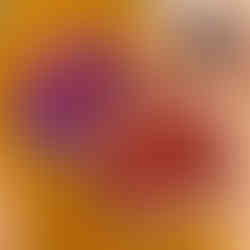




























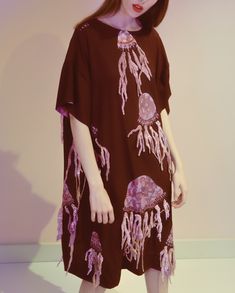



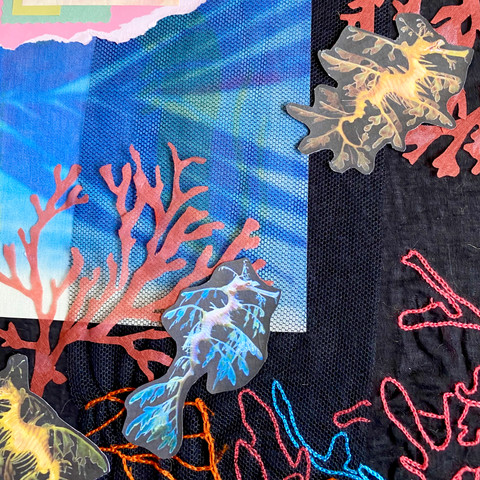


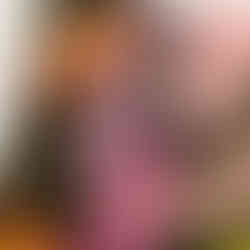
















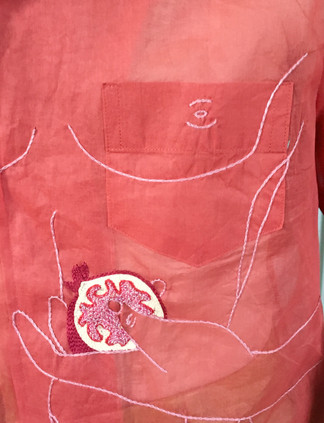


Comments